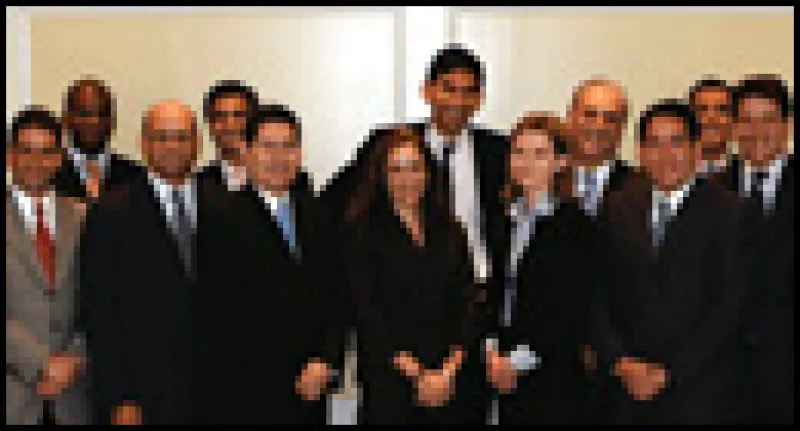Latin America's strongest corporates are making the most of abundant liquidity in the syndicated loan markets, while banks struggle with thin margins.
| Round table participants debate the future of syndicated loans. |
It is unlikely that Grupo Techint could have pulled off such a feat, if it weren't a multinational with operations in four continents. Fernando Aftalion, executive syndications director for Latin America at Rabobank International in New York, spoke at LatinFinance's syndicated lending roundtable in New York in November. He says the transaction proved that "banks are willing to look at companies on a standalone basis and disassociate them from sovereign risk. Local banks in particular look at these companies on the strength of their credit and their global business."
Acquisitions such as Grupo Techint's purchase of Hylsamex are breathing new life into a market that collapsed in the wake of Argentina's default. Latin American companies are making the most of low interest rates to refinance and expand their businesses. Several – such as Telmex, Cemex as well as Techint – have gone on acquisition sprees. Jorge Wilmer, managing director for Latin America in emerging debt capital markets at HVB Group and an arranger of the Techint loan, says he expects to see more acquisition-related loans next year – so long as the economic outlook remains positive as campaigning for presidential elections in Brazil, Mexico, Colombia and Peru heat up. "I think some of the new money deals will be driven by strategic cross-border financings as these companies in Latin America's growing economies look to expand in new markets."
| Fernando Aftalion |
Indeed, the benign global economic environment triggered a wave of refinancing in 2004 that continues. Felipe Macia, director at HVB, says: "Borrowers really took advantage of low interest rates to refinance ahead of next year's elections. They are swapping into longer-term debt and compressing margins. Until market conditions change, I think we will continue to see them financing themselves at this level." This round of refinancing is marked by the much larger size of individual transactions. According to Dealogic, the capital markets and investment banking consultancy, six of this year's top 15 Latin American loans were above $1 billion. And data provider Thomson Financial says syndicated lending increased 19.6% between January and September to $28.3 billion from a total of $22.7 billion in 2003 when the market started to revive. Loans are growing in size, and they are becoming fewer in number. Although loans are in demand, not all is well in the market. The pool of lenders is dwindling as margins shrink, maturities lengthen and syndicates contract. Capital markets in Mexico, Chile and Brazil give top-tier corporates wider financing options than ever before. Miguel Siliceo, CFO of Mexico's government-owned trade finance bank Bancomext, says life was a lot harder a decade ago. "After the peso devalued in Mexico in December 1994, it was impossible to get money for Mexico at any price. These days, Bancomext can borrow unsecured long term loans for just 20 basis points over Libor," he says. Bancomext refinanced a $300 million term loan facility earlier this year, shaving 35 basis points off its first tranche to reduce its margin from 55 basis points to 20 basis points over Libor. It halved its margin on its second tranche to 35 basis points over Libor from a split margin of 70 basis points to 80 basis points over Libor. It maintained its three-year maturity on the first tranche and five-year maturity on the second tranche.
Siliceo expects the pressure on pricing in the syndicated loan market to continue. He says: "The local markets are putting pressure on the syndicated loan market. For the best corporates, Mexico's peso bond market is their main source of funding." Daniel Seiner, managing director at Miami-based BroadSpan Asset Management says: "We see borrowers having large amounts of power most evident in pricing being very, very tight. It's very hard for an investor to invest. The value these days is finding an asset that really pays you for the risk. Experience tells us that in bad times, all borrowers do badly. In Argentina, for example, the good companies went down with the bad companies. Why should I buy the tightest loans in the market?"
Capital Market Competition
And bankers doubt that Latin America's election season will tip the scales back in favor of lenders. Jean-Philippe Adam, managing director of Latin America credit markets at Calyon Securities, says: "The threat to the syndicated loan market comes more from alternative sources of funding than from upcoming election cycles. The loan product is under pressure from other sources of funding such as the local debt markets, securitization and even the equity markets."
In the more mature markets of Mexico and Chile, where blue chips have driven down pricing in the bond markets, they are still the focus of syndicated lenders. According to Thomson Financial, investment-grade rated Mexico accounted for 59% of loan volume distribution in Latin America in the first nine months of this year, compared to 36% in the same period in 2002. Chile remains level at 9% for this first nine months of this year and the first nine months of 2002. Brazil now accounts for 18% compared to 25% in the first nine months of 2002.
Rubens Amaral, chief commercial officer and general manager of Bladex, the Latin American trade finance bank, says: "With non-investment grade borrowers, banks make a much better return. In countries like Brazil with a high concentration of non-investment grade borrowers, the conversation is probably more on the banks' side, where you have higher returns."
Bankers expect Brazilian companies to drive demand for loans next year as corporates take advantage of Brazil's improving creditworthiness to refinance more expensive debt. Indeed, some of Brazil's blue chip companies already boast investment-grade ratings. Raul Campos, investor relations manager for Petrobras, says investment-grade Brazilian companies are taking advantage of the opportunity to drive down their cost of funding by refinancing outstanding obligations for cheaper, longer-dated debt.
Mexico's blue chips led the way in 2004 and 2005. Mexico's fixed-line telecommunications company Telmex refinanced and increased a $2.24 billion unsecured facility to $2.5 billion, pushing out the tenors on its two tranches to four and six years, while trimming pricing by 15 basis points and 10 basis points on each tranche. Mexican cement multinational Cemex refinanced an $800 million senior revolving credit facility and reduced it to $700 million while cutting 20 basis points and 25 basis points off its three- and five-year tranches.
| Jean-Philippe Adam |
Pricing for blue chips in Mexico and Chile has fallen to such lows that weaker credits are beginning to demand better conditions on their pricing too. Says Calyon's Adam: "We have seen second-tier companies in Brazil asking us to match the loan packages for first-tier companies, and that just doesn't make sense." As a result of margin pressure, some banks are questioning their mission as lenders in Latin America. Says Wilmer: "We see certain banks staying out of the primary syndication and picking deals up in the secondary market if they make more economic sense." According to Loan Pricing, a syndicated loan market data company, banks have fled the market. At its peak in 1997, 215 banks were active in the market. That number fell to 139 in the first nine months of 2005. Banks that cannot compete in local currency will be marginalized. In Mexico, a growing number of syndicated loans are in pesos. Marco Solís, head of corporate banking in Mexico for Rabobank International, says: "The secondary banks in Mexico have a lot more funding than they had a decade ago. International banks used to just target the big credits, but they are growing more aggressive in talking to secondary corporates. If you are an international bank without peso funding in Mexico, it is a severe handicap." Solís says dollar funding is still in demand in Mexico because Mexican interest rates continue to be more volatile than Libor rates. Dollars are also more attractive, because it is cheaper for companies to borrow in dollars and swap the loan into pesos in Mexico's fast-growing and highly liquid currency swap market.
Wilmer says the pressure on margins is changing a market once driven by relationships. He says: "I think banks are becoming more transactional and more opportunistic, as margin compression and lower returns force them to reevaluate the overall profitability of client relationships."
Amy G. Dulin, corporate counsel at Hughes Hubbard & Reed, says some borrowers are also taking advantage of the liquid environment to demand less stringent documentation. For example, one borrower recently tried to negotiate dispensing with the Libor meltdown clause, which is designed to provide a framework for parties to a lending contract to follow if Libor cannot be determined. "Typically, it would allow the agent to go out and poll pre-determined reference banks to get a Libor rate or would allow the borrower and agent to negotiate to come up with alternative funding, or would provide a generic reference to a lender's cost of funds," Dulin says. "This is an example of how some borrowers are trying to move away from some of the market formalities that are in place and this could be a dangerous trend."
Growing the Middle Market
Other banks are seeking out new relationships by venturing into the middle market. Marc Brito, senior syndication officer at FMO, the Dutch government development agency, says he sees many opportunities in financing second-tier companies in Latin America that are overlooked by commercial banks. In November, FMO closed a $60 million syndicated loan for an orange juice producer in Costa Rica. FMO arranged the loan and syndicated it to four Central American banks. FMO has been providing subordinated loans as part of its loan packages, but now wants to syndicate subordinated loans to parties interested in providing the quasi equity product. Brito doubts commercial banks would be participants. He says: "Funds experienced in providing mezzanine financing and the European Developmental Financial Institutions (EDFI), a group of European development banks, are more likely to participate."
Naturally, going down market has its hazards. Aftalion says bankers should pay attention to the structure of ownership and succession, the quality of management, how highly leveraged a company is and its access to funding. Many lenders will not even show their credit committees deals involving companies that are not audited by international auditing companies. Investors such as BroadSpan's Seiner see opportunities with middle-market companies in countries such as Mexico and Brazil, where structure and security packages can be used to mitigate risks. But Dulin cautions that "as banks move into the second tier, the lenders have a responsibility to make sure that these borrowers, who may not be as sophisticated or familiar with the international market as first-tier borrowers, have an understanding of market standards and what they were agreeing to."
Seiner says new investors such as private equity funds, asset managers and hedge funds are becoming increasingly important players in the syndicated loan market because unlike commercial banks, few are restricted by country or credit limits. Indeed, hedge funds help Latin America's nascent secondary market for syndicated loans. Seiner says hedge funds are growing as participants in the secondary loan market where borrowers are often unaware that their relationship banks are selling their loans to hedge funds. Dulin says borrowers still have legal recourse to their lenders, even if they sell their participations in a loan on to a third party. She says: "Typically the borrower will demand that the lender has to retain the decision-making authority for most matters so that the lender stays on the hook, which is important when you start selling participations in the loans to the private equity market and hedge funds."
Rabobank's Aftalion says greater competition in the syndicated loan market is forcing banks to become more innovative. "The pressure on fees and margins is forcing bankers to think more creatively in terms of structures, distribution and originating new business. We are no long thinking in terms of the pure loan syndication proposal but the whole suite of debt products."






